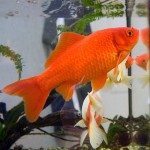What are flukes?
These are tiny white parasites similar to worms.
Symptoms of flukes
The 11 signs to look for:
- clamped fins occur early
- isolation and redness of skin
- refusal to eat food and listless
- rubbing against the surface
- split fins may signify a fluke infestation in the aquarium
- appearance of mucus on gills
- quick breathing
- bloated body
- blood streaked fins
- eyes bulging
- white eyes
Untreated flukes can result in bacterial gill infection and disable the oxygen processing through the gills.
They transmit an awful bacteria and drill holes into the skin of your fish. This may cause ulcer diseases.
There are 2 types.
Skin and gill flukes also known as monogenea and flukes that reside inside fish known as Trematodes.
Gill Flukes
It’s easy to identify monogenea flukes. They normally attach around the gills of your fish using 2 hooks and a sucker.
After attaching they continually feed on your goldfish skin cells.
Gill Flukes Treatment
Flukes increase quickly and 2 interval treatments are recommended that normally take 4 to 7 days. This ensures new flukes born after the adults are killed are treated.
There are various treatment options including: PraziPro, prazi pond (Praziquentel) if you’ve a pond, anti-fluke or fluke tabs.
PraziProFluke tabs are recommended for quarantine tanks. One tab is able to treat 10 gallons.
Prazi Koi Pond is the pond treatment to use.
Salt Bath Treatment
Salt treatment can be combined with any treatment described above. It supports the formation of the natural protective slime layer of the fish and doesn’t interfere with treatment. In case of using chlorinated water make sure you use a de-chlorinator.
How to Prevent Flukes
1.Stop new outbreaks of fluke infections by treating any fresh plants or goldfish.
Quarantine intervals should be at least 1 month. Avoid adding new goldfish that are possible carriers of fluke infection once you establish a healthy fish community. Consult your dealer about whether the fish you purchase have been quarantined.
2. Flukes can also be caused by deficient water conditions.
- Clear does not imply clean!
Water changes should be performed regularly to reduce infection problems and the incidence of Flukes in your tank. Make sure you have a high quality water supply.
3. Flukes can be caused by congestion.
Check your tank doesn’t have too many fish in it. Healthy fish growth is facilitated when there’s enough water to fish ratio.
How many fish can be kept in a tank?
As a guide
- For 2 common goldfish, ideally your tank volume should be at least 30 gallons and 4 feet long.
- For 1 fancy goldfish your tank should be 3 feet long and a volume of at least 20 gallons (for 1 fish).
If you want to keep more than 1 goldfish in your tank add an extra 10 gallons for each additional fish.
Another way to calculate:
For small fish, the rule of thumb is stock a fish 1 inch in length per 2-5 gallons of water. EG a 30 gallon tank could hold 6 x 1 inch fish, or 2 to 4×3 inch fish.
Remember you want your fish to grow and thrive, so don’t keep them in a tank that’s too small.
In my opinion, Flukes are probably the worst parasite infection because they cause so much damage.
In most instances, unfortunately, you’ll notice flukes after your fish have died in large numbers. Therefore it’s very important to be able to make a disease diagnosis in the early stages of the fish showing signs of illness. A microscope may help to observe signs of infection.








